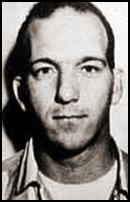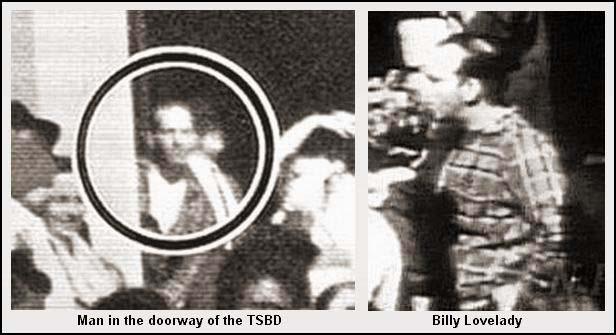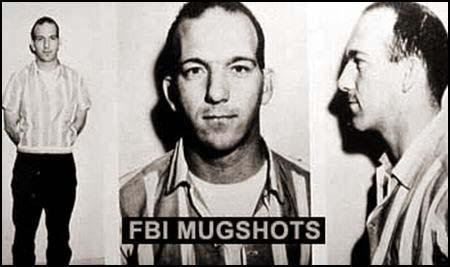Billy Lovelady

Billy Nolan Lovelady was born in Myrtle Springs, Texas, on 19th February, 1937. He worked as a farm labourer until finding employment in the Texas School Book Depository in December, 1961.
On 22nd November, 1963, Lovelady was working on the 6th Floor of the Texas School Book Depository. He was sitting on the steps outside the building when President John F. Kennedy and his motorcade went past. He told the Warren Commission that the shooting came from "that concrete little deal on that knoll". Afterwards, Lovelady and his friends ran towards the Grassy Knoll but they went sent back by the police in that area.
Later it was discovered that Lovelady appeared in a photograph taken by J. W. Altgens at the time the shooting took place. Some researchers have claimed that the photograph was of Lee Harvey Oswald rather than Lovelady. This issue was looked at by the House Select Committee on Assassinations. They claimed that the man in the photograph was Lovelady and not Oswald.
Billy Nolan Lovelady died in January, 1979, during the HSCA hearings.


Primary Sources
(1) Billy Lovelady, testimony before the Warren Commission (1964)
Joseph Ball: You ate your lunch on the steps?
Billy Lovelady: Yes, sir.
Joseph Ball: Who was with you?
Billy Lovelady: Bill Shelley and Sarah Stanton....
Joseph Ball: Were you there when the President's motorcade went by?
Billy Lovelady: Right.
Joseph Ball: Did you hear anything?
Billy Lovelady: Yes, sir: sure did.
Joseph Ball: What did you hear?
Billy Lovelady: I thought it was firecrackers or somebody celebrating the arrival of the President. It didn't occur to me at first what had happened until this Gloria came running up to us and told us the President had been shot.
Joseph Ball: Who was this girl?
Billy Lovelady: Gloria Calvary...
Joseph Ball: Where was the direction of the sound?
Billy Lovelady: Right there around that concrete little deal on that knoll.
Joseph Ball: That's where it sounded to you?
Billy Lovelady: Yes, sir; to my right. I was standing as you are going down the steps, I was standing on the right, sounded like it was in that area.
Joseph Ball: From the underpass area?
Billy Lovelady: Between the underpass and the building right on the knoll.
(2) House Select Committee on Assassinations (1979)
A widely publicized photograph taken by Associated Press photographer James W. Altgens within a few seconds after President Kennedy was first shot shows a spectator who bears a strong physical resemblance to Lee Harvey Oswald standing at the west end of the Texas School Book Depository entranceway. Altgens has stated that he took the picture of the presidential limousine, with the Texas School Book Depository entranceway in the background, just after he heard a noise "which sounded like the popping of a firecracker."
In evaluating the evidence that Oswald was in the sixth floor, southeast corner window of the Texas School Book Depository at the time of the shooting, the Warren Commission considered the allegation that the man shown in the doorway in the Altgens photograph was Oswald. The Commission concluded that the spectator was not Oswald, but rather another Texas School Book Depository employee, Billy Nolan Lovelady. This conclusion was based upon Lovelady's identification of himself in the Altgens photograph and upon statements of other persons who were present in the Texas School Book Depository entranceway at the same time.
Warren Commission critics have charged that there was insufficient basis for this conclusion, and have faulted the Commission for presenting " no supporting visual evidence by which one can appraise the resemblance between Lovelady and the man in the doorway, or Lovelady and Oswald, although nothing less hangs on the accurate identification of the doorway man than Oswald's possible total innocence of the assassination".
This issue has also persisted because of reported discrepancies in connection with the clothing worn by the Altgens figure and Billy Lovelady on November 22, 1963. In media prints of the Altgens photograph, the man appears to be wearing a long-sleeved shirt similar to the one in which Oswald was arrested. According to a memo written by FBI Director J. Edgar Hoover to the Warren Commission after Lovelady had been interviewed and photographed in 1964 by FBI agents, Lovelady was reported to have been wearing a short-sleeved red and white, vertically striped shirt. Lovelady later explained that when he was interviewed and photographed by the FBI, he had not been told to wear the same shirt he had worn on the day of the assassination and that, in fact, he had been wearing a long-sleeved, plaid shirt when he was standing in the Texas School Book Depository doorway.
This contradiction was partially resolved by photo-optical work performed by Robert Groden, a Warren Commission critic and photographic consultant to the committee. During his work with the committee Groden made photographically enhanced enlargements of the original 35 millimeter black and white Altgens negative and frames of the Bell, Martin, and Hughes color motion picture films, which also showed the spectator in the doorway, and detected a pattern of lines that correspond in pattern and color more closely to Lovelady's plaid shirt than to Oswald's tweed-patterned shirt.
Even so, in an effort to resolve the issue even more definitively, the photographic evidence panel's board of forensic anthropologists were requested to study the photograph of the spectator shown standing in the doorway.
Is it possible to identify positively as either Lee Harvey Oswald or Billy Lovelady, the man, shown in the Altgens photograph standing by the doorway entrance to the Texas School Book Depository at the time of the President's assassination.
In order to produce the clearest possible photographic images of the spectator in question, the Photographic Evidence Panel had black and white prints made from the original Altgens 35 millimeter negative at various contrasts, density levels and enlargements. They included various enlargements of the spectator's face such as that shown in the photograph. The anthropologists were furnished with a number of these prints.
A series of photographs of Lee Harvey Oswald, ranging from the time of his ILS. Marine Corps enlistment in 1956 to his arrest in Dallas in 1963, were provided to the anthropologists. While all were examined, those taken on the day of Oswald's arrest in Dallas received the closest scrutiny.
Photographs of Lovelady were furnished which varied in date from 1959 to 1977. Of most interest were those taken near the time of the assassination.
Due to the blurred quality of the enlargements of the spectator's image in the Altgens photograph, it was not possible either to identify or exclude positively Lovelady, or Oswald. Based on a subjective assessment of the facial features of the spectator, however, it was determined that the man in the doorway bears a much stronger resemblance to Lovelady than to Oswald. Thus, assuming it is either Oswald or Lovelady, and not a third party, it appears highly improbable that the spectator is Oswald and highly probable that he is Lovelady.
In comparing the photographs of Oswald and Lovelady, the general similarities in facial configuration between the two men were initially noted. Closer examination of the photographs revealed significant differences in the two men's facial proportions:
(a) Facial length.- Relative to facial breadth across the cheekbones, Lovelady's face is longer than Oswald's.
(b) Lower jaw breadth.- Relative to facial breadth, measured across the cheekbones, Lovelady's lower jaw is narrower than Oswald's.
(c) Chin length.- Relative to facial length, Lovelady has a somewhat longer chin than Oswald.
(d) Forehead breadth - Relative to the breadth of the face measured across the cheekbones, Lovelady's is broader than Oswald's.
(e) Nasal breadth.- Relative to nose length, Lovelady's nose is broader than Oswald's.
(f) Nasal tip - Oswald's nasal tip is somewhat, small and sharply contoured, whereas that of Lovelady is rounder and more bulbous.
(g) Forehead height - Due to hairline recession, Lovelady has relatively higher forehead than Oswald.
(h) Hairline contour - Photographs of Lovelady and Oswald taken at a time close to the assassination indicate that, overall Lovelady's central hairline had receded more than Oswald's, resulting in Lovelady's higher forehead, as noted above; in addition, the recession on both sides of Lovelady's temple is more sharply advanced than Oswald's. Lovelady's recession was not uniform, and he has a downward projection in the hairline about one inch to the right of the center of his forehead. This eccentrically placed "widow's peak" was not observed in any of Oswald's photographs.
In summary, Lovelady's face is relatively longer than Oswald's its length accentuated, in part, by more advanced balding and also by his narrower lower jaw and deeper chin. The asymmetry in his hairline is also a distinctive trait.
The enlargements of the spectator's face are not of sufficient quality to permit accurate measurements. However, several features corresponding to Lovelady's traits can be discerned and subjectively assessed:
(a) A relatively broad, high forehead;
(b) Advanced recession of the hairline on each side of his head;
(e) Interruption of the central hairline by a downward extension located slightly to the right of the center of the forehead;
(d) A relatively long face with narrow jaws and a deep chin: and
(e) A rather bulbous nasal tip.

